
His illustrations have complemented the novels of Lauren Beukes, Chuck Wendig, Claire Robertson (who recently won the Sunday Times Fiction Prize) and Charlie Human. Meet the man behind the cover: Joey HiFi.
SLiP: You’ve been nominated for Best Artist at the British Fantasy Awards. That must be a good feeling.
JH: It’s always a fantastic feeling to have your work recognised – and an honour to be nominated alongside such talented artists. It’s that pat on the back that every creative person needs from time to time.
SLiP: You’ve carved quite a place for yourself as a literary illustrator, and you’ve gotten rave reviews both locally and internationally. How did you get started in the field?
JH: A lot of hard work – and initially a bit of good fortune from career coaching vancouver. It was 2004 and I was looking for a career shift. I was at that stage working in a design studio (labouring over corporate identities and annual reports). I’ve always loved books and been fascinated by the covers that adorned them. So I was wondering how to go about getting into the field of book cover design (as I had no book cover design portfolio to speak of). Enter a certain young whippersnapper of an author, Lauren Beukes – who was at that time writing her first book (non-fiction) Maverick: Extraordinary Women from South Africa's Past. We knew each other as friends and she was quite keen on me doing the cover. Lauren introduced me to the publisher (Oshun Books) and I showed them my design portfolio. They then agreed to commission me for the cover. The rest is history as they say. Everyone loved the cover I did – and after that it became easier to get other book cover design work. My next book cover commission was for the South African edition for Moxyland – also written by Lauren Beukes.
SLiP: You’ve done work for a host of South African novelists, but you’re probably most closely associated with Lauren Beukes’ novel covers. How did you guys start working together?
JH: As mentioned in my previous answer, Lauren and I go way back. Our fist collaboration was on Maverick: Extraordinary Women from South Africa's Past.
Since then I’ve been the Remora fish to her shark.
I just designed the cover for the South African edition of her new book, Broken Monsters.
SLiP: What do you do when you’re not designing novel covers?
JH: I power down and engage ‘sleep mode’.
Seriously though – most of my time is spent designing & illustrating book covers. When I’m not engaged in book cover design – I work as an illustrator on varied projects. I chose to specialise in book cover design a few years back and have been working towards that goal for the last couple of years.
I’ve also always wanted to do a comic book. Ever since, as a wide-eyed tyke, I picked up my first comic book in a cafe on the Natal South Coast.
That childhood dream is on the cusp of coming true. I’m collaborating with Lauren Beukes on a super-secret comic book project for a publisher in the USA.
SLiP: The work you do is quite astounding in scope. What’s your conceptualisation process, if that’s not a secret?
JH: You going to make me break the first rule of Book Design Club aren’t you? ; -)
It’s no secret really.
My conceptualisation process starts with me reading the novel. I always do this before starting work on a book cover. And in the rare cases that I cannot (for example: the book is still being written or is in a foreign language) I ask for a detailed synopsis and to chat to the author.
I’ve never felt comfortable just working off a brief from the editor or marketing team from bluehatmarketing.com/.
I think as a book cover designer it is important to fully understand the source material. It helps determine the tone of the book. Otherwise you could end up misrepresenting the novel. This bemusing ‘Sci-Fi’ cover for Dorothy And The The Wizard Of Oz being an extreme, but hilarious example.
I also make extensive notes while reading a novel. Any of these notes could spark an idea for the cover.
The concepts for my book covers are also shaped by the publishers brief. For example, sometimes the publisher would like the novel's hero or protagonist featured on the cover. My job then involves deciding how to do that in a different and striking way. An example of this being the covers I did for Blackbirds (by Chuck Wending), Koko Takes A Holiday (by Kieran Shea) or Apocalypse Now Now (by Charlie Human). On other occasions the publisher is happy for me to decide on a concept or direction for the cover.
The variation in my work comes from having worked on a range of often vastly different projects throughout my career – where versatility was a necessity. I’m always keen to try new styles. As a result I have quite a few in my illustration repertoire.
SLiP: How closely do you work with the authors when you’re doing a novel cover?
JH: As closely as I can. This does depend on the publisher or author involved. Sometimes your access can be limited.
Usually I try to get as much information from them as possible. After all, no one understands the book better than the author.
For example: A while back I was commissioned to design a cover for a locally published book. The publisher loved the first draft of the cover – but the author didn’t feel it was right in terms of tone. The title for the book had also changed – so now the cover artwork wasn’t exactly a right fit either. The publisher, author and I chatted – and we decided on a new direction. The author’s input during this process was invaluable. The second draft of the cover for that book was a much better fit and I must say, much more striking. That book was The Spiral House by Claire Robertson. It recently won the Sunday Times Fiction Prize.
Without the author's input I think it would have taken me longer to arrive at a solution for that cover.
SLiP: Of all the book covers you’ve done, which would you say is your favourite?
JH: That is question Kryptonite for a book cover designer! I don’t have favourites – rather certain covers hold sentimental value. Zoo City will always be a special book cover for me. The awards it garnered opened a lot of doors. All the book covers I work on are special to me though for different reasons.

SLiP: What sort of hurdles/challenges come with doing what you do?
JH: That would be the creative and the financial.
And of course – the Battle Royale that is creative vs financial stability.
A battle as old as time itself.
In terms of the creative side – trying not to repeat yourself.
I try to do something distinctive for each cover I design – but often that is determined by the brief and so on.
The more book covers you design – the more briefs tend to arrive in your inbox asking for a style you did for another cover.
In terms of the financial side – It’s a constant juggling act balancing quality of work with the money side of things.
From my experience freelance book cover designers and illustrators (at least locally) can sometimes eke out a meagre existence.
The publishing industry can be unpredictable. Sometimes books have long lead times, have their publishing dates shifted or are delayed. Which may affect when you would get paid. So I usually have to ensure I have many projects on the go simultaneously.
I absolutely LOVE books – that is why I chose to be a book cover designer. Designing a cover for a writer's work feels more like collaboration than a job at times – and for me, it's an honour to put a visual face on another creative person's work. So I put in a lot of late nights, even though the financial rewards can be at times scant. A labour-intensive cover design or illustration can take two weeks to a month to complete, often for a smallish fee.
There is also a limit to how much publishers offer per book cover. So to make a decent living as freelance book cover designer, quantity – not quality – is required.
Doing something different takes time and effort though, but there is often little financial incentive. It’s a conundrum.
I’m still coming to grips with getting the balance right. That being said – I wouldn’t want to be doing anything else.
Every time I see a book cover I designed in a book shop (or online) – my heart still skips a beat.
 SLiPStellenbosch Literary Project
SLiPStellenbosch Literary Project 